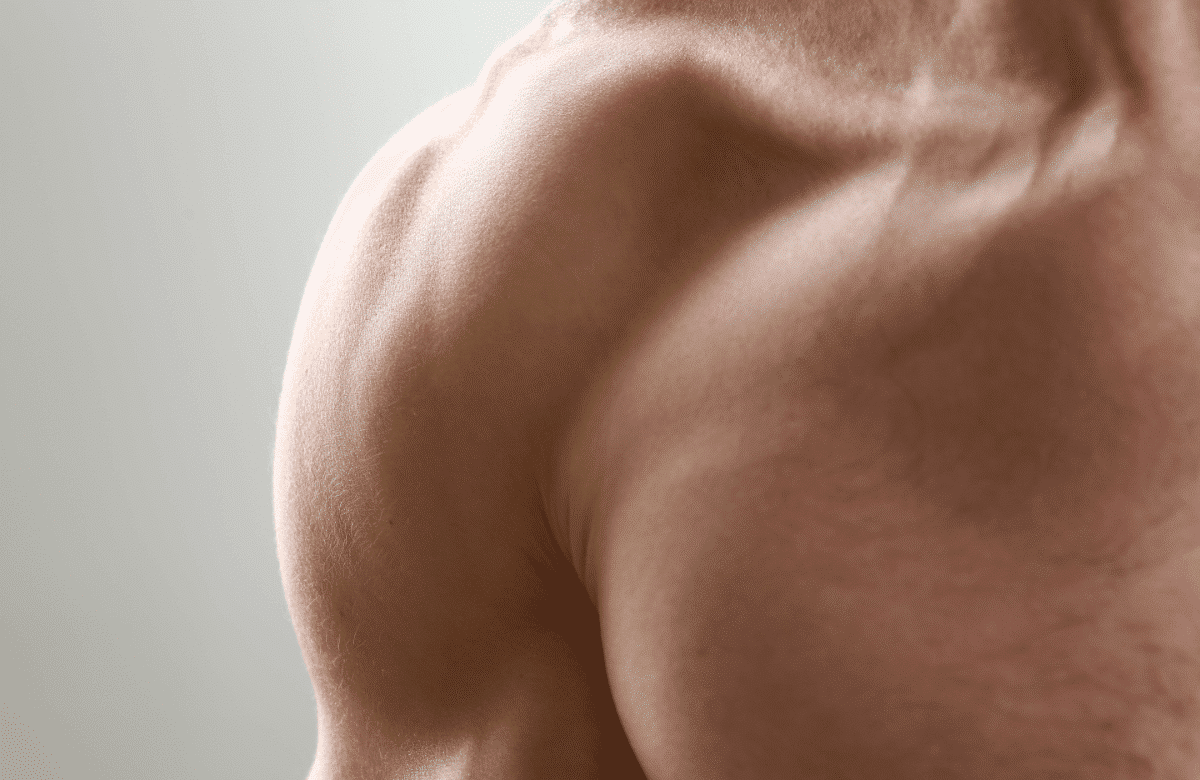The shoulders are often one of the more neglected muscle groups, but if you want a truly well-rounded physique and impressive physical strength, you can’t afford to leave them behind! Aesthetic-looking shoulder caps are one of the most coveted parts of a bodybuilder’s physique, but they do require a bit of focused shoulder training.
But you can’t just double up on your shoulder sets or start lifting 2x the amount of weight you’ve been before. The shoulders are a complicated piece of anatomy, consisting of 3 muscles and a joint, so if you want to build them up, you have to do it properly.
Keep reading to find out how the shoulder works, the best exercises for caps, mistakes to avoid, and how to structure your training for the best success.
Jump to:
- What Does It Mean to Have Shoulder Caps?
- Anatomy 101: Understanding the Shoulder Caps
- Why They’re Important for Building a Muscular Physique
- Essential Principles for Building Bigger Shoulder Caps
- The Best Exercises for Shoulder Caps
- Common Mistakes to Avoid
- Shoulder Training Tips for Bigger Shoulder Caps
What Does It Mean to Have Shoulder Caps?
When you’ve built great muscle in your shoulders and they have a rounded look to them, they’re known as shoulders caps. If you’ve neglected them a bit, even if you’ve built other muscle in your upper body, they end up looking strangely narrow and out of proportion with the rest of your upper body.
Shoulder caps are well-defined and noticeable, without looking like they’re too much. There are basically two parts to this: one, shredding fat so your shoulder muscles stand out as much as possible (all about the diet), and choosing and doing the right exercises for shoulder caps with excellent form and the right weight to challenge them to grow.
Anatomy 101: Understanding the Shoulder Caps
To figure out how to build your shoulder caps, the first thing you need to know is exactly how the shoulder muscles are structured. There are three distinct heads in the shoulder caps—the deltoid muscles. They consist of the anterior (front) deltoid, medial (side) deltoid, and posterior (rear) deltoid.
The shoulder is a complex joint. As well as the delts, you’ll also find the rotator cuff, which is a group of muscles and tendons including the infraspinatus, supraspinatus, and teres major muscle. These are an important part of the entire shoulder and should be trained for strength and flexibility, but if we’re talking just about the shoulder caps, it’s the deltoids that we’re going to be focusing on.
It’s also interesting to know that the shoulder is the most mobile joint in the body, which means it’s even more important to know how to train it so you can build real muscle mass, enhance shoulder stability, avoid common shoulder injuries, and maintain shoulder health.
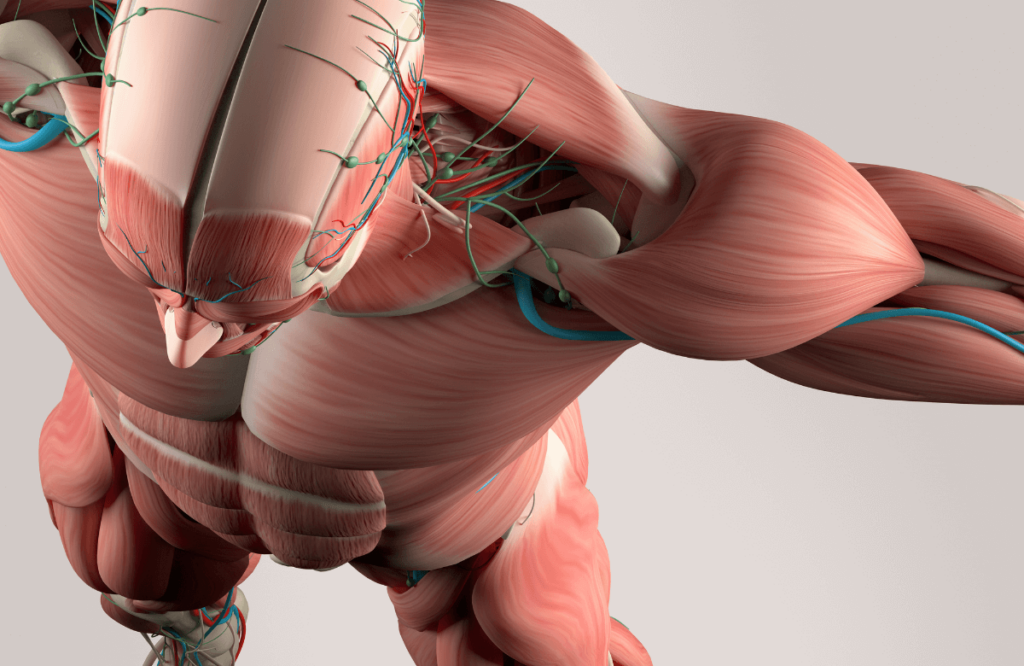
Anterior Deltoid
The front deltoid is often the most-worked of the three, because it has a role in almost every pressing exercise, like most chest exercises. Every time you lift your arm in front of you, your anterior delt is activated. If you stand in front of the mirror, you’ll be looking right at your front delts.
Medial Deltoid
The medial deltoid (also called the side or lateral deltoid) is responsible for helping you lift your arm out to the side. There’s very few exercises that train this particular muscle or movement, so if you really want side delt activation, you need to place extra focus on it with lateral delt raise exercises for your outer shoulders to grow. If you stand sideways to the mirror, you’ll be looking at your medial deltoids.
Posterior Deltoid
The rear delt is notoriously hard to hit, as it’s a small muscle hidden in the back of the shoulder. But it’s one of the most crucial elements of good shoulder function, so like the side delt, it needs focused attention to grow in size and strength.
Why They’re Important for Building a Muscular Physique
You can do all the bicep curls and deadlifts you want, but if your shoulders are small and weak, you’re going to look out of proportion. It’s interesting to know that a great set of shoulder caps score big points in bodybuilding competitions, so there’s a definite pleasing aesthetic to them.
They’re especially important if you’re aiming for that classic torso taper, from a narrow waist to a wide, muscular upper back. Plus, it’s hard to build attractive shoulder caps, in comparison to bigger muscle groups like the back and legs. So well-built shoulders is also a great sign of dedication and commitment to your cause.
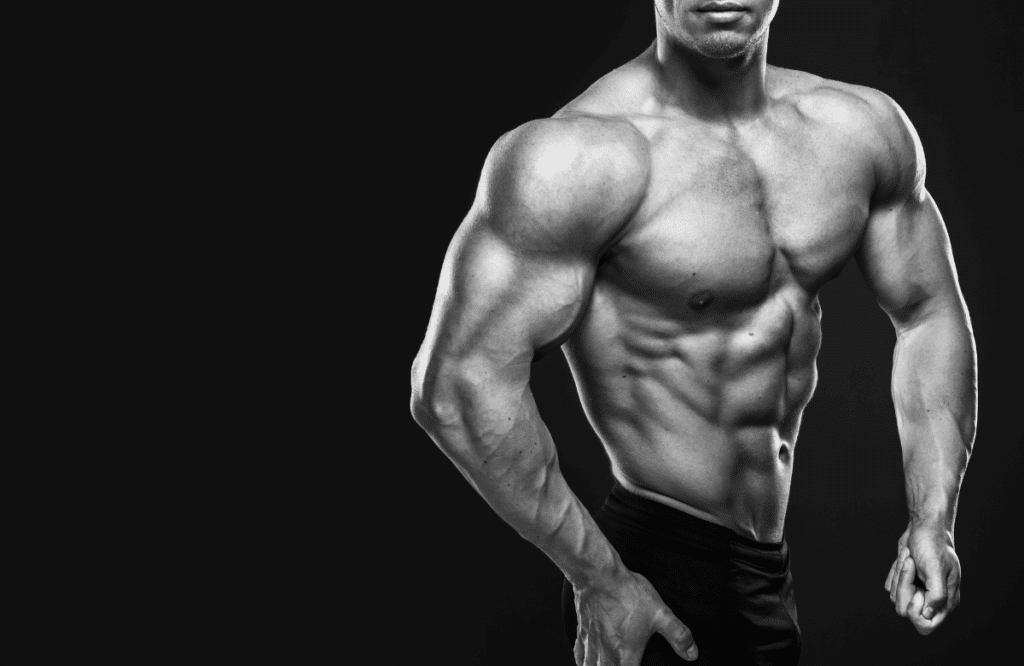
Essential Principles for Building Bigger Shoulder Caps
You can’t rock up at the gym, lift some weights over your head, and hope for great shoulder caps to materialize. You’ve got to put in solid effort and be patient. Building aesthetic shoulder caps has two main foundations: a balanced workout routine and proper form.
Importance of a Balanced Workout Routine
Some personal trainers will tell you to train each muscle group once a week, while others will have you training a few more times. There’s no right or wrong, as long as you’re hitting that sweet spot between training too little, too light and overdoing it in either frequency or weight.
It might take a bit of experimenting to figure this out. A once-a-week shoulder-specific workout is a great way to start, so beginners should consider it. Four to five dedicated shoulder exercises, 3 to 4 sets of each, making sure to hit every deltoid.
As you kick over into being an intermediate, experienced weightlifter, you can consider splitting into 2 sessions a week if you want to build more muscle and shoulder strength. Here, you can split into one all-round shoulder session and one focusing only on side and rear delts, because your front delts get plenty of action in other exercises. This is a great way to build them really nicely and evenly.
Proper Form and Technique: A Crucial Foundation
Even if you get your workout routine right, you’ll be doing yourself a huge disservice if you’re performing the movements with improper form. Don’t neglect form—it could be the worst mistake you make in your quest for serious shoulder caps.
The key to good form is to lift the right amount of weight for the right number of reps. Science suggests that 4 to 6 reps with great form is optimal for men to gain muscle, while 8 to 10 reps is ideal for women.
As for weight, you should be lifting enough to challenge your muscles, but you should be able to do every rep with good form. The moment you lose your form, you know you’ve hit your weight limit. Here’s how it works:
- Choose a weight you can lift comfortably with perfect form for the lower number of reps (4 for guys, 6 for girls).
- Keep lifting with this weight until you can hit the upper number of reps with perfect form (6 for guys, 10 for girls).
- Up the weight to something you can lift with perfect form for the lower number of reps.
- Follow this pattern indefinitely.
It might take you a few weeks to a few months to move up to the next weight, but it’s all about challenging your muscles while doing the exercise with impeccable form and progressing in a safe and effective way. Be patient!
The Best Exercises for Shoulder Caps
Okay, so now you know how to structure your workouts and how best to do them. Now for the best exercises for shoulder caps. Remember to structure your workout to include more medial and rear delts than front delts, as they’ll get benefits from other exercises.
Overhead Shoulder Press
One of the “big five!” The overhead press, also called the military press, hits all three of the deltoid muscles, so it’s a must. You can do it standing, which will activate the core and stabilizing muscles, or seated, which is a bit more stable.
You can also do it with either a barbell or dumbbells. A barbell is more stable for those who have weaker shoulders, but some might find dumbbells to be more comfortable.
If you’re standing, keep your feet about shoulder-width apart, squeeze your glutes, and tuck your pelvis in and under to avoid “posterior tilt”. Even if you’re seated, make sure to keep your back straight.
Inhale, brace your core, and push the weight overhead. Avoid arching your back, and do your best to keep your wrists straight, not bent backward with the weight resting on your hands.
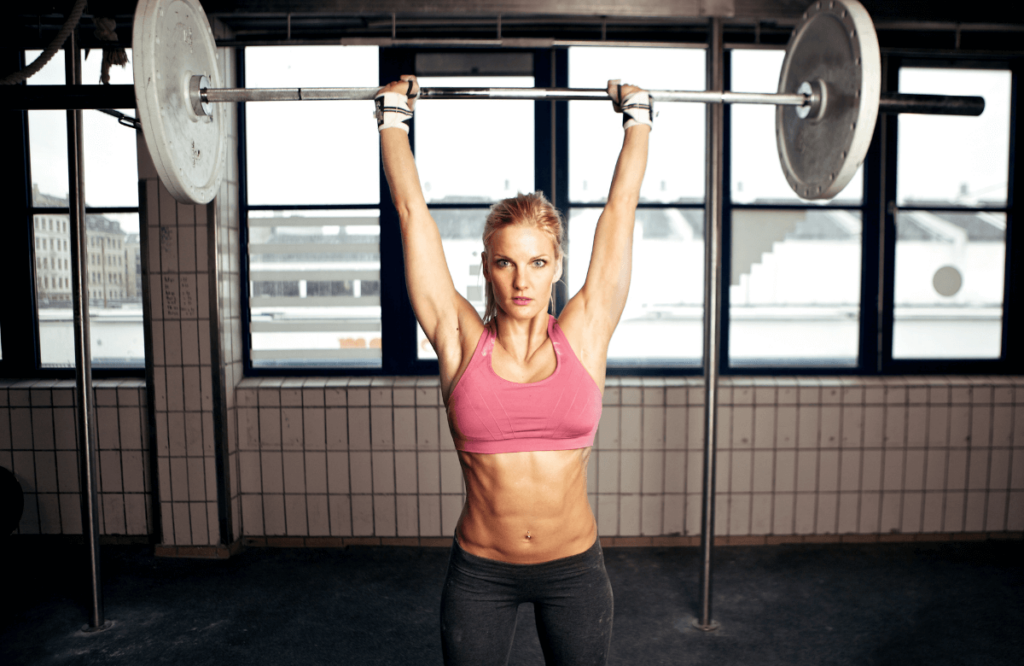
Lateral Raises
The lateral raise movement works the medial deltoid. Again, you can do this seated or standing, depending on your preference. If you’re standing, have your feet hip-width apart, tuck your glutes, holding the dumbbells at your sides.
Keep your core tight, and without using momentum, lift the weights up and out to your sides. Keep a slight bend in your elbows, and lift until your arms are parallel to the floor—shoulder level, no higher. Then, bring them down in a controlled way.
Quick tip: Bring your shoulder blades back and down before you start the movement. Also, if you rotate your hands a little so your pinky fingers are a little higher than your thumbs, you’ll get a touch more activation in the muscle.
You can also do the lateral raise with the cable machine, if you prefer. You’ll have to do it one side at a time, but it could be a little more stable for some.
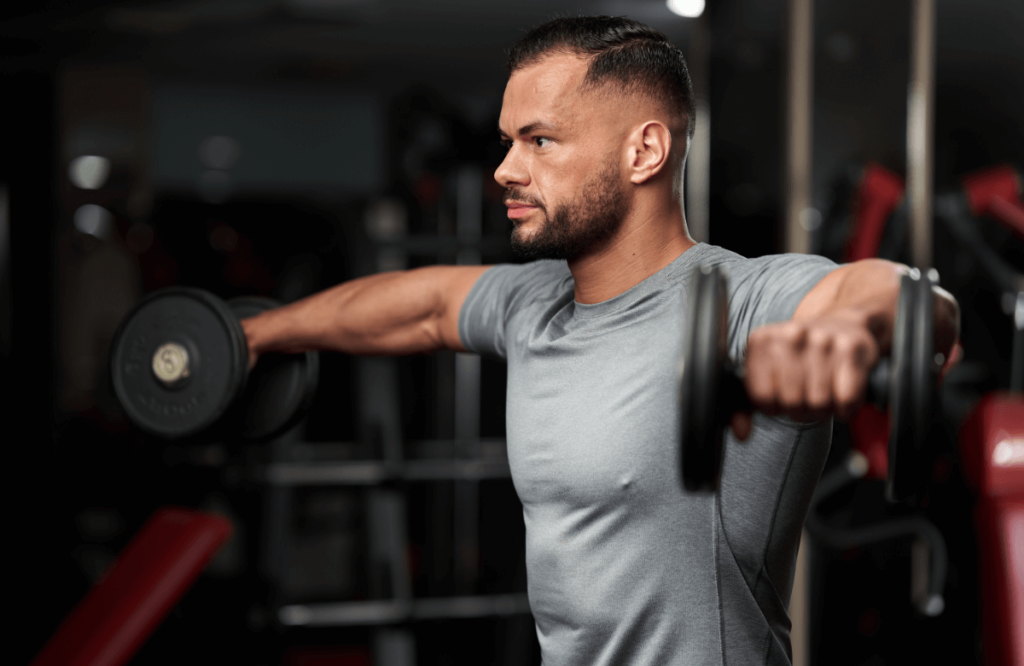
Dumbbell Reverse Delt Fly
Perfect exercise to build those rear delts and round out your capped shoulder look! You can do it standing, but you’ll have to bend at the waist until your back is almost parallel to the ground. Alternatively, you can lie chest-down on a 45-degree angle bench.
Whichever way you do it, you want to start with your dumbbell-holding arms hanging in front of you. Bring the weights up and out to your sides by contracting your rear delt muscles. Keep your elbows slightly bent throughout the movement and squeeze your shoulder blade at the top.
Make sure to avoid using momentum during this exercise. Your core should be tight, and you should always be in control of the movement, even on the way down.
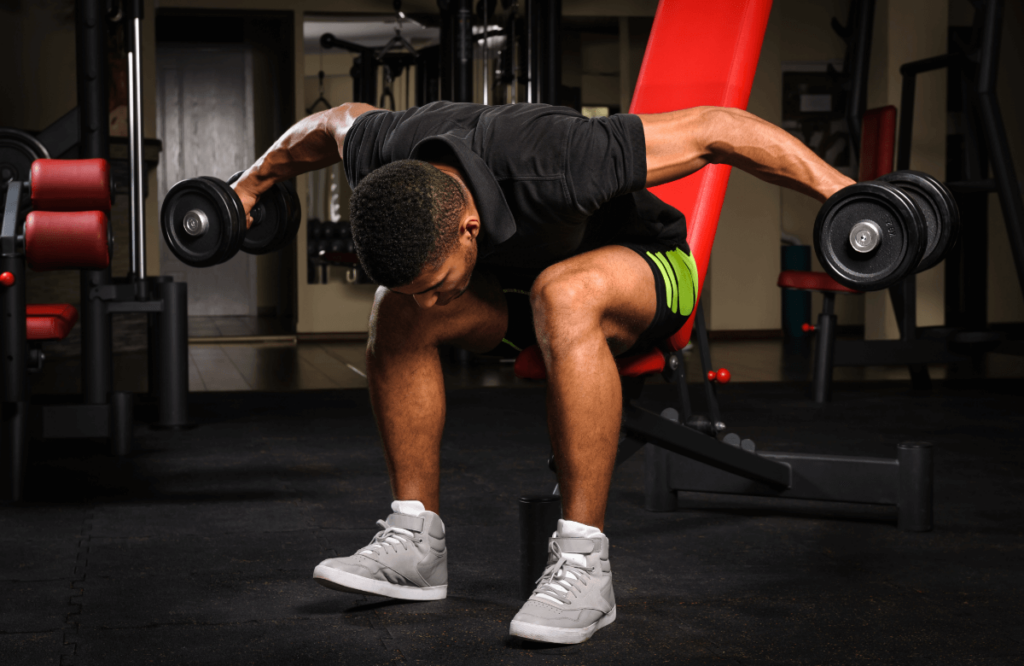
Arnold Press
Yep, these are named after Mr Schwarzenegger himself! Seated or standing, grab a pair of dumbbells and start with them at shoulder-height, but with your palms facing inward, towards your shoulders.
Like a regular shoulder press, tighten your core and glutes if you’re standing, and press the weight overhead. As you bring them up, rotate your arms so you end up in the normal palms-out position at the top of the movement.
As you come down again, rotate them again so you end the exercise with your palms facing your shoulders once more. It’s best to do this exercise on an incline bench at around a 70-degree angle, which gives a bit of a wider range of motion than an upright bench.
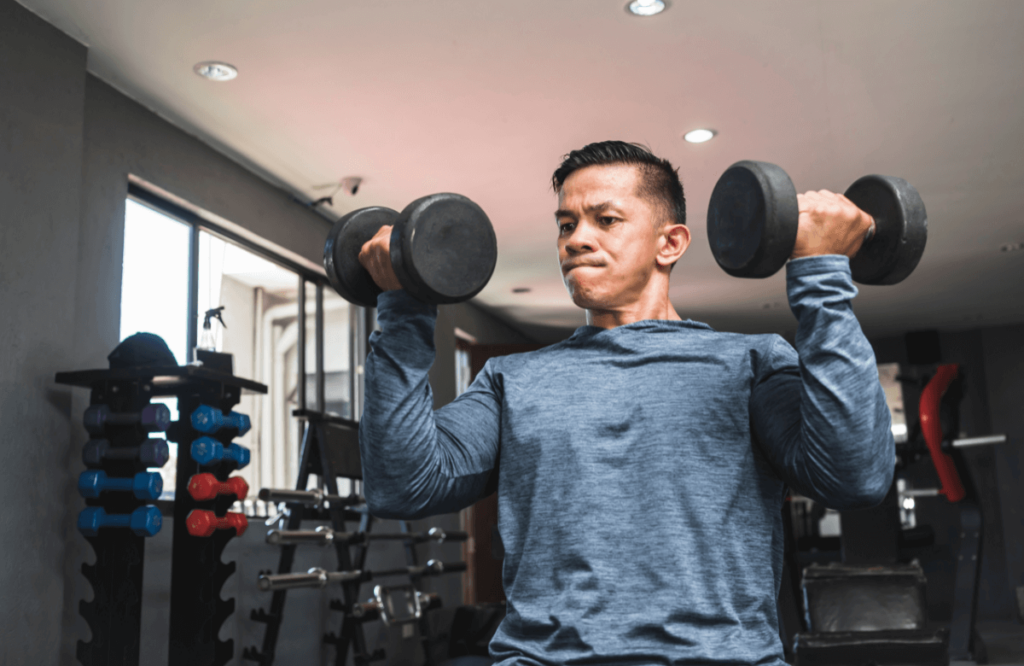
Front Raise
This one targets the front delts. The barbell front raise is a little more stable, but you can also do dumbbell raises. Stand with your feet shoulder-width apart, holding a barbell with an overhand grip, resting on the front of your thighs.
Keeping your arms as straight as possible, lift the weight in front of you. Make sure you aren’t using momentum to get the weight up, and bring it down in a controlled way.

Kettlebell Single-Arm Press
CrossFitters might prefer to do overhead presses with a kettlebell. With your feet around shoulder-width, get into the starting position—with the kettlebell in front of your shoulder at chest height, elbow tucked in, and the bell resting on your forearm.
Keeping your core tight, press the kettlebell overhead. Avoid bending your knees and using that upward momentum to help you lift. This should be a strict press. The motion is a little closer to the Arnold press, as there’s a bit of a rotation as you extend your arm.

Upright Row
You can do the upright row with dumbbells, but it works best with a barbell. Grab it with a fairly close grip, closer than you would if you were using dumbbells. Plant your feet as far apart as feel stable to you, and hold the barbell in front of your thighs with an overhand grip.
Tighten your abs, and lift the barbell straight up, along the front of your body, up to just under your chin. Keep your elbows higher than your hands throughout the movement, to get the best activation of the deltoids.
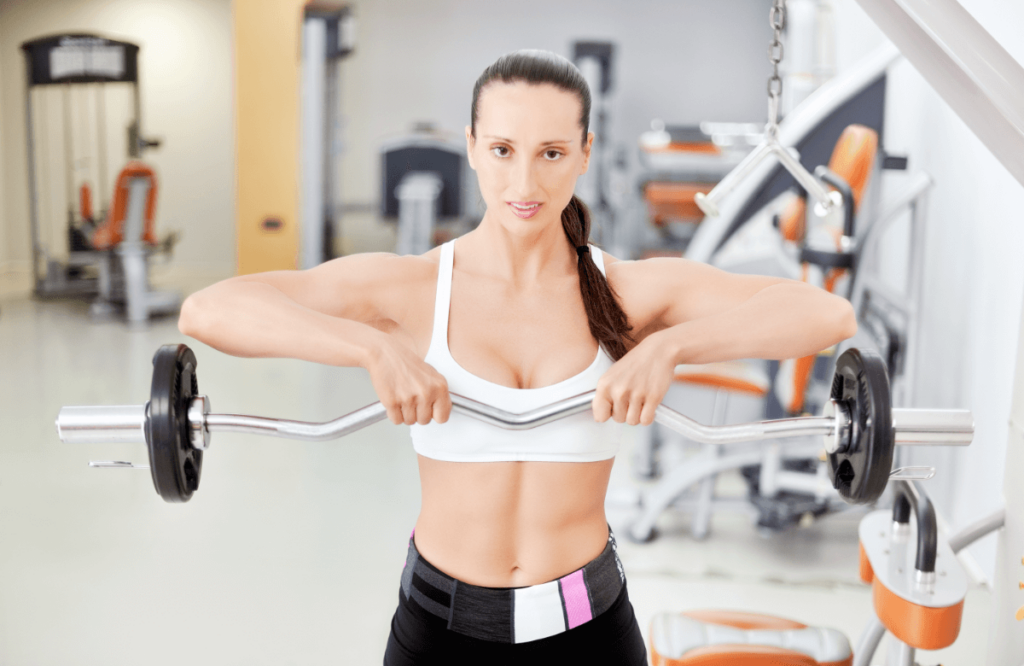
Common Mistakes to Avoid
Pay particular attention to these easy-to-make mistakes. If you can avoid them, you’ll be well on your way to building some serious shoulder muscle.
Going Too Heavy
As mentioned above, trying to lift too heavy not only comprises muscle growth, but it can lead to severe shoulder injury scarily easily. If anything, go TOO light until you find that sweet spot, because once you’ve injured a shoulder joint, it’s never quite the same.
If you’ve had a previous injury already, be extra careful here. Instead of heavier weights, start light and go up in small increments until you find the perfect weight. Form will be essential to prevent jarring or wrenching of that all-important shoulder joint, and if you’re lifting heavier weights than you should be, your form will be harder to keep.
Unbalanced Training
The front delts get a lot of activation one chest day, so they’re getting trained A LOT. If you nail the front delts during your shoulder workout and ease up on the others, you’ll end up with an unbalanced physique.
The best way to do it is double-up on the side and rear delt exercises. So for every front delt exercise you do, make sure you’re doing 2x side delts and 2x rear delts. This’ll be the best way to ensure that those shoulder caps develop all-round.
Shoulder Training Tips for Bigger Shoulder Caps
Ready to build those shoulder caps and round out your physique? Here are some top tips for building muscular shoulders the right way.
Mind-Muscle Connection
Don’t underestimate this phenomenon! When you’re lifting, put your mind on the muscles that you’re working. As they say, “energy flows where attention goes”, so when your attention is on your deltoids, you’ll be able to tell that they’re activating.
This also helps you to do every movement with the correct form. Exercise is not just physical—the mental aspect is huge as well, and you’re missing out if you aren’t focusing down on the muscles you’re working.
Progressive Overload
The key to muscle hypertrophy is progressive overload. That means slowly but surely upping the weight you lift so your muscles are always challenged. When you can reach your max reps (6 to 10), up the weight and use the new weight until you can hit that max again, and keep doing it that way.
There’s a place for light weights and tons of reps, but if you want to build serious muscle and get that capped shoulder look, then it’s not what you should be doing. Progressive overload will be your best friend along the way to building muscular capped shoulders.
Incorporating Drop Sets and Supersets
Although progressive overload should be your goal, there are a few ways to get there. Drop sets and supersets are two of those ways. We recommend them for more advanced lifters, but if you’re new to heavy weights, they’re still worth knowing about.
For drop sets, use a weight that you would normally use to get your 4 to 6 or 8 to 10 reps. Lift with excellent form for as many reps as you can—in other words, until failure, until you can’t lift with proper form.
Then, without “resting”, pick up slightly lighter dumbbells or reduce the weight on your barbell and do the same—as many reps as possible until you lose your form. Keep going this way (going lighter and lighter until failure).
Supersets are a great way to save time. You’ll do one exercise and follow it up immediately by another that works a different muscle. For example, do one that works your front delts, followed by one that works your rear delts.



